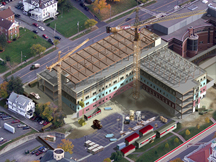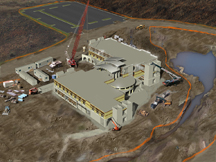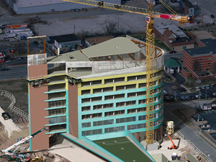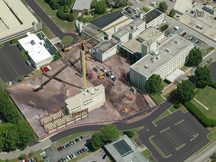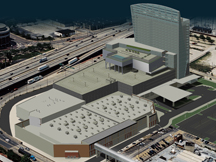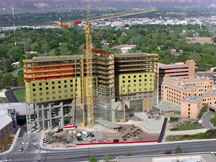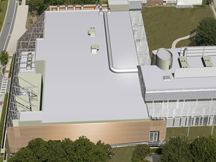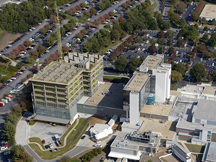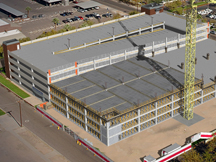Vinci Virtual Construction Montage™
A 4d image bringing together photographic context
and virtual construction modeling
A virtual construction model typically covers the development of the subject building and the configuration of major logistics over the construction schedule. This model may be set in a digitally-modeled context or it may stand alone in space. A virtual construction montage or VCM is the superimposition of the virtual construction model or output from such on a photograph of the worksite, usually taken from height. This “superimposition” is called “photomontage” or simply montage.
Scope and Products
The VCM can show some or all of a worksite. When all of the worksite is visible from a single vantage point, the resultant 4d general overview can effectively address or at least introduce construction schedule and logistics. When a 4d VCM overview is annotated as in these examples (1→, 2→), it can serve as a brief and effective summary of your construction plan. When a portion of the worksite is studied, the resultant 4d worksite detail can address more specific operations in an interview or to inform user groups on construction activity that will affect them. VCM is also widely applicable to the production of construction vignettes, short studies of a detail of work often intended to illustrate how construction activity will temporarily or permanently impact the Owner’s logistics, user group circulation, or the community. Indeed, currently the widest application of VCM is the generation of construction vignettes.
Is VCM Right for Your Application?
Virtual construction montage requires a partial construction of a digital model and a basis image that is usually a photograph used to convey context. The photograph is intended to reduce the time required to model context, or to provide “real-world” (vs. modeled or rendered) context. (Again, the placement of the modeled output on the basis image is called “montage”.) VCMs can be “painterly” as part of a community relations campaign or they can be highly effective communicators of key concepts like this flood plain illustration, practically winning the bid. Because montage tends to eliminate the need to produce detailed context, it normally proceeds about twice as fast as a service like the Vinci Digital Worksite™, which models the terrain, major and minor improvements neighboring the subject, as well as the subject under construction. The montage technique proves most effective when all important processes on the worksite are visible from a single vantage point. Because the model is being superimposed on a photograph and because amendments to the basis image and environment surrounding the model output are normally necessary, the montage is a two-part process. This means that montage proceeds economically when change is minimized.
This doesn’t mean that two or more views aren’t possible (examples 1A→, 1B→ and 2A→, 2B→); in fact multiple views can be produced, provided basis images are available for them. However, each carries the burden of two-part rendering, meaning that it might be more economical to use a service like Vinci Digital Worksite™ when all is said and done. Also, late-stage changes are a fact of life for construction interview presentations. Obviously, any methodology that produces construction visualization must be somewhat flexible. VCM is simply less flexible and more labor intensive than straight digital modeling or BIM output. Use VCM when you need quick, convincing results economically produced provided change is minimized.
In summary, montage is effective and economical when most or all activity is visible from one viewpoint, and your team is more or less certain that the strategy won’t change between the start of the montage process and delivery.
Vinci’s Virtual Construction Montage™ service
Vinci LLC has been producing virtual construction montages since its establishment in 2004. The process was heavily used early on, producing 4d worksite overviews called Vinci General Construction Sequences™; over 100 sequences have been produced. The montage approach dominated between 2004 and 2007, and still finds use, especially in amendments. Currently most GCS™ viewsets are efficiently and flexibly generated by Vinci’s integrated Digital Worksite™ modeling service, with Vinci VCM™ serving as a “shortcut” to effective and convincing visualization. The same process behind Vinci VCM™ is regularly applied to Vinci Vignettes™. Each worksite is different; Vinci has a rapid method of roughly estimating work based on apparent project levels ⇒. Normally time is of the essence with RFPs, and late-breaking or changing directives are common, thus the rough estimates have proven to be the most effective means of assessing an inquiry over 250 iterations, a dozen clients, and over seven years of experience.
This page last modified Friday 14 December 2012.

